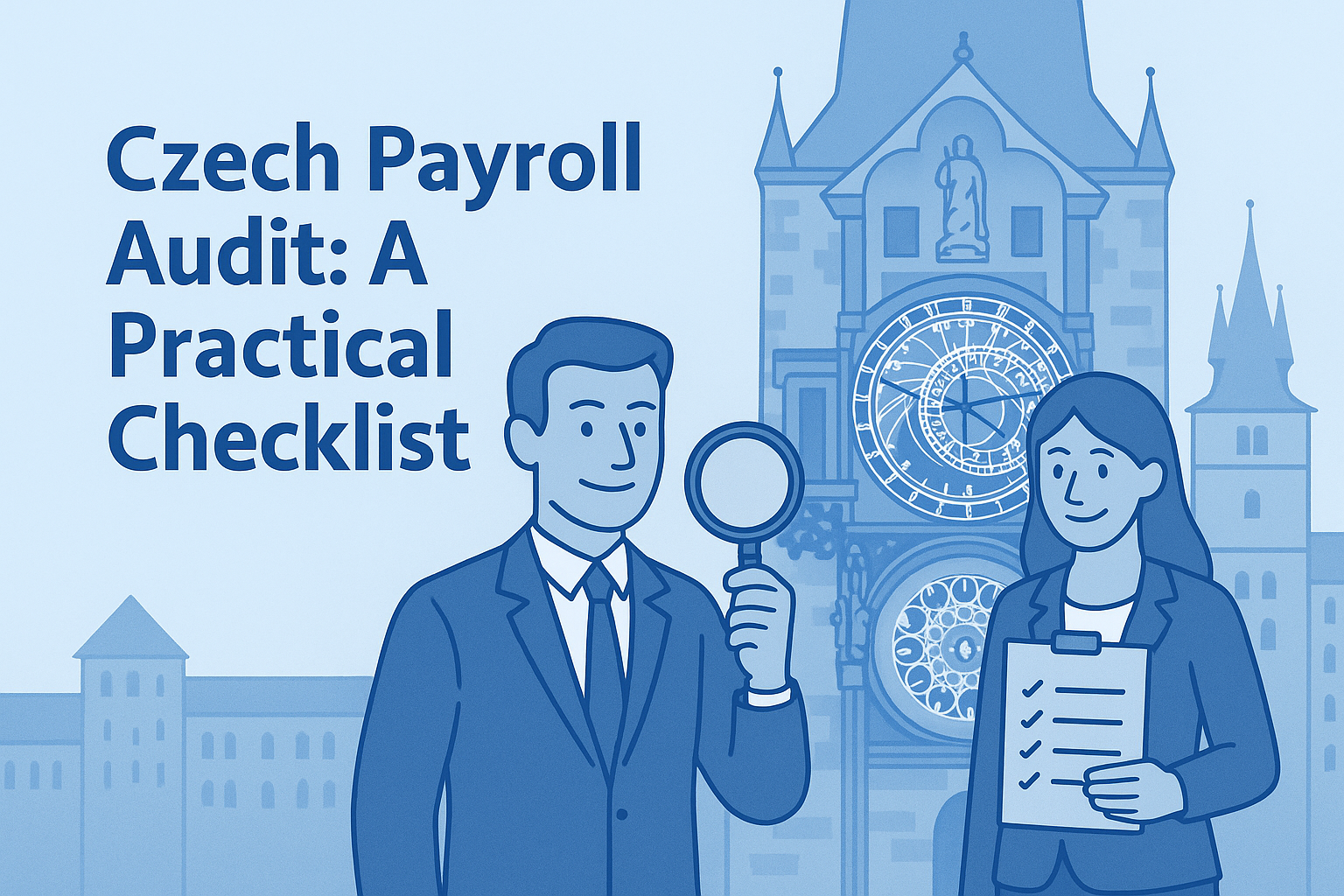What a Czech payroll audit covers
- Gross → net calculation logic (15%/23% tax bands, caps, and rounding)
- Correct application of tax credits and allowances per signed declarations
- Social/health insurance treatment on HPP, DPP, and DPČ arrangements
- Fringe benefits, reimbursements, and taxable/non-taxable split
- Monthly/annual filings and payments to Czech authorities
- Data retention, employee files, and audit trail quality
Why it matters
Rules change, thresholds move, and teams grow. Regular audits reduce compliance exposure, eliminate rework, and keep employee payslips consistent. For international firms, audits align Czech specifics with global reporting.
Who benefits
HR, Finance, and leadership. Employees see fewer corrections; controllers get cleaner reconciliations; auditors get faster evidence.
For added clarity, the Czech Payroll Audit: A Practical Guide framework below shows exactly what to check each month and quarter.
Common risks found in audits
- Incorrect tax base due to missed allowances or misordered child credits
- Misapplied insurance on DPP/DPČ (threshold logic not documented)
- Late or missing filings; incorrect references or payment splits
- Misclassified roles/contracts; wrong onboarding documentation
- Poor evidence for benefits, travel reimbursements, or meal contributions
Step-by-step payroll audit checklist
- Scope & sampling: Define months, entities, and a risk-based sample (new hires, DPP/DPČ, bonuses).
- Gross→net validation: Recompute representative payslips; confirm 15%/23% taxation and any caps.
- Tax credits & declarations: Verify signed forms, child/study evidence, and single-claim rules.
- Insurance treatment: Check thresholds and employer/employee splits; reconcile to reported totals.
- Filings & payments: Match due dates, confirm submission receipts and bank references.
- Benefits & reimbursements: Validate taxable vs non-taxable treatment and receipts.
- Documentation: Ensure audit trail (inputs, approvals, correction logs) is complete.
- Findings & fixes: Classify severity, correct in-period where feasible, and document preventive actions.
Simple monthly controls
- Deadline tracker (filings/payments) with owner + backup
- Variance check: headcount, total gross, and employer costs
- Exception log: retro pay, terminations, one-off bonuses
Quarterly & annual controls
- Quarterly sampling of DPP/DPČ for threshold application
- Reconcile cumulative taxes/insurance vs. authority receipts
- Pre- and post-year-end spot checks; archive year-end evidence
Documentation & evidence
Keep a consistent folder structure: inputs (contracts, declarations), calculations (payslips, audit sheets), filings (confirmations, bank proofs), and controls (checklists, approvals). Good evidence shortens external audits and speeds up corrections.
Note: “Net salary” is a statutory figure; “take-home” reflects cash after personal deductions/reimbursements. See the guide below.
FAQ
What is a Czech payroll audit?
A structured review of calculations, credits, insurance, filings, and process controls to confirm compliance and prevent penalties.
How often should we run it?
Quarterly for dynamic teams; minimally once a year, with additional spot checks around year-end.
Who should lead it?
Payroll lead or Finance controller with HR support; international companies may add a global payroll coordinator.
Top mistakes?
Misapplied tax credits, missed DPP/DPČ thresholds, late filings, misclassified contracts, and weak documentation.
Related resources
Key takeaways
By following Czech Payroll Audit: A Practical Guide, HR and Finance teams can minimize compliance risks, keep payroll accurate, and maintain employee trust. Regular reviews make year-end processing easier and safeguard your company against penalties.
Next steps
Create a simple audit plan, assign owners, and log findings with due dates. Most issues are solvable within the same payroll run if caught early. If you need a neutral review, we can help.
